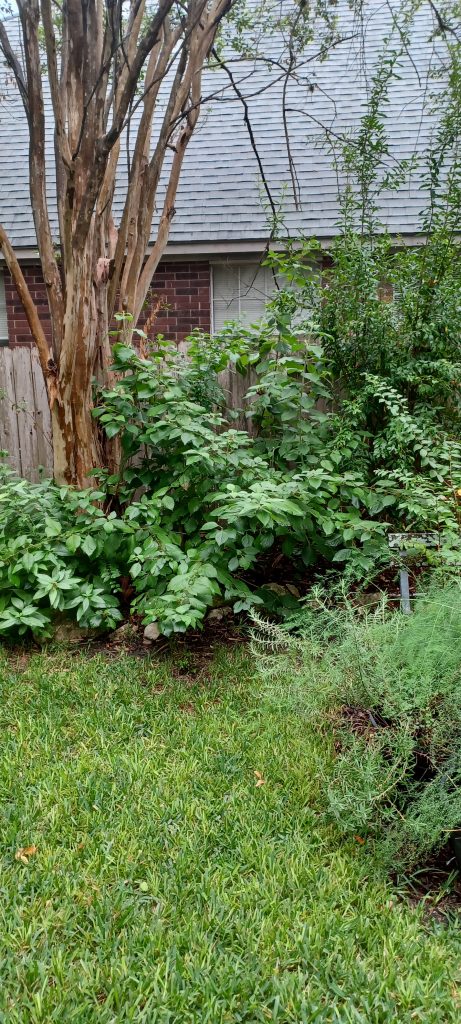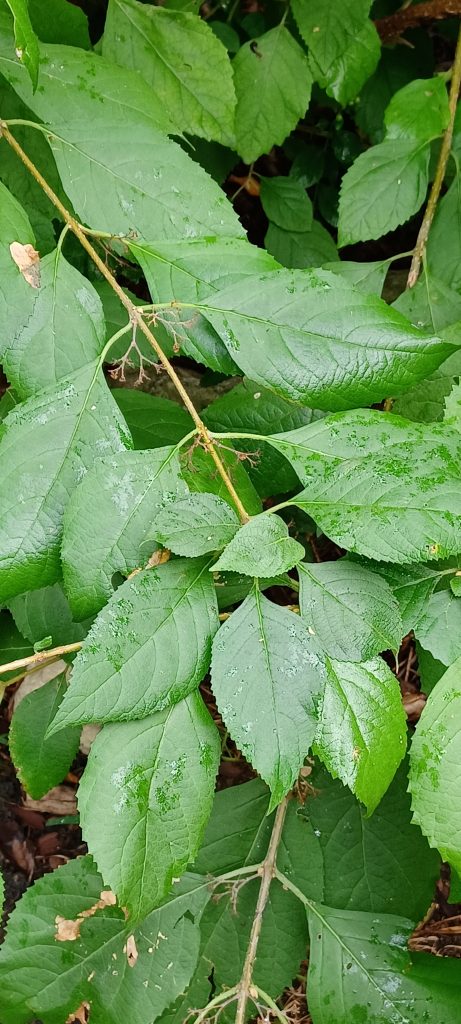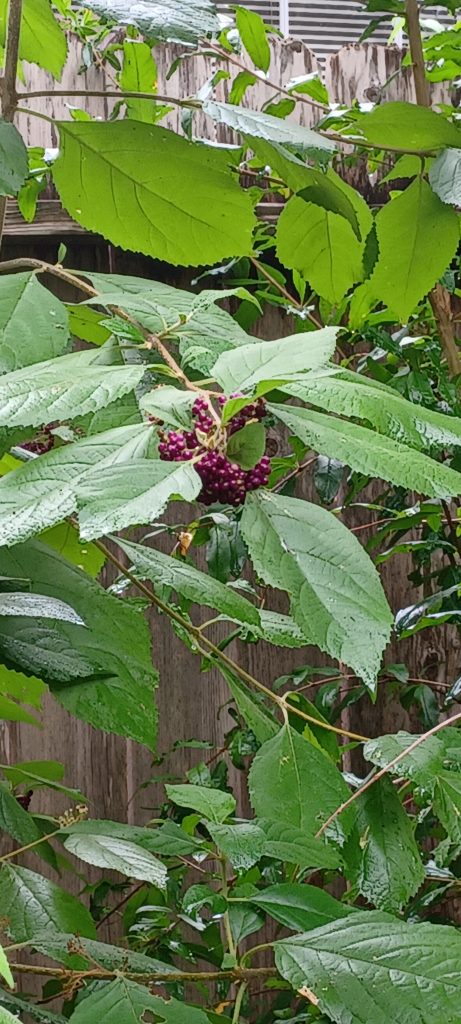By Mary Cennamo, Bexar County Master Gardener
February 2024

American Beautyberry (Callicarpa Americana) derives its name from two Greek words: fruit-“calli” and beautiful-“carpa.” The name is appropriate because of the plant’s breathtakingly beautiful magenta fruit clusters that line its branches during August and September.
GROWING CONDITIONS
This cascading shrub is a Texas native that grows in the wild, mostly in East Texas but is also successfully grown in the southeastern United States from Oklahoma to Maryland as well in the Caribbean and in northern Mexico. American Beautyberry is found in open meadows and under tree canopies, particularly in moist areas.
The shrub is hardy (Zone 6 to 11) and grows well in both acidic and alkaline soils, though it prefers loose, well-drained organic soil. While this lovely deciduous plant prefers moist soil conditions, it is a local favorite since it tolerates drought and freezing conditions.
My American Beautyberry survived last summer’s heat wave despite the many days of 100+ degree temperatures. During this period, the plant showed little signs of stress and minimal wilting of leaves even though I watered it just a once a week with a drip system. Even with this small amount of care, this plant survived through the hottest months of the summer.
It is also extremely winter hardy: my American Beautyberry survived the 2021 blizzard snowstorm even though it is not planted nearby my house and didn’t receive the extra ambient temperature. I also didn’t cover it with any blankets, although I did insulate it with 2 inches of mulch. A very hardy plant!

My American Beautyberry is located between a crape myrtle and a pomegranate shrub on the south side of my garden along a fence line and receives dappled sunlight throughout the day. This cascading shrub usually grows to 4 to 6 feet and just as wide, but can grow as tall as 10 feet with extra moisture and mild winters. I’ve read it does well in full sun, but if placed in partial shade as an understory plant, it will produce the most berries for local wildlife and for your use.
The magnificent blooms occur in the late spring and early summer and last through the end of the summer and early fall. The small flowers provide nectar for butterflies, bees and other insects that are in your yard throughout the bloom time. The flowers are petite, white, and yellow in color, and resemble a small bouquet of flowers that eventually turn into the fruit. The fruit itself grows in grapelike clusters of beautiful magenta seed pods that wrap around each stem. Each pod has 4 seeds and I have read that livestock and wildlife eat the fruit and spread the seeds, which eventually are deposited across the woodlands of Texas.
Beautyberries can be propagated by soft stem cuttings for producing baby plants that will grow like the mother plant. Since the berries only last for 3 to 4 months of the year, they should be harvested and made into jams and jellies if you can get the fruit before the birds do! Native and migrating birds, especially the Northern Bobwhite (quail) love the fruit.
COLOR & STRUCTURE OF THE LEAVES & BRANCHES

The shrub has an interesting unique leaf color and structure. The leaves are serrated on the edges and may be 3 to 9 inches long with a width of 3 to 5 inches. The light-yellow green leaves have a fuzzy-looking texture to them especially on the young, underside leaves due to the small hairs that cover the bottom surface of the leaf.
The plant’s “fur” protects its leaves from moisture evaporation, which is why the American Beautyberry is so drought tolerant! The top of the leaf is a different green color than the bottom side, giving it an interesting, dual-colored look in the garden. The oval leaves are striking because they grow adjacent to one another on the branches, with the flowers and eventual fruit berries wrapping around the leaf petiole, an inch-length leaf stem that attaches the leaf to the branch.
The branches also have a unique structure. The stems are 4-sided and boxy and the branches have an 18% protein component that attracts cattle, deer, rats, squirrels, raccoons, foxes, armadillos, and opossums that eat the stems for their nutrients, especially in the wintertime when food is scarce.

So, reader beware: this is not a deer-proof plant even though I have read varying opinions about this. For example, the staff at Lady Bird Johnson Park says that the white-tailed deer love and graze on the American Beautyberry year-round, while other authors suggest that the deer nibble on the plant but cause minimal damage and consider it to be deer resistant.
In summary, the American beautyberry is a beautiful low-maintenance shrub for your yard with eye-catching magenta-colored berries. It is a great plant for sustaining the wildlife that visit your yard and requires minimal pruning: simply trim the dead branches in the late winter or in the early spring, or more vigorously in the late winter or early spring. Trimming the branches will encourage and result in a bushier shrub with more new growth, and more berries for the birds or for you if you are making jam this year.
Happy Gardening!
All photos by Author

